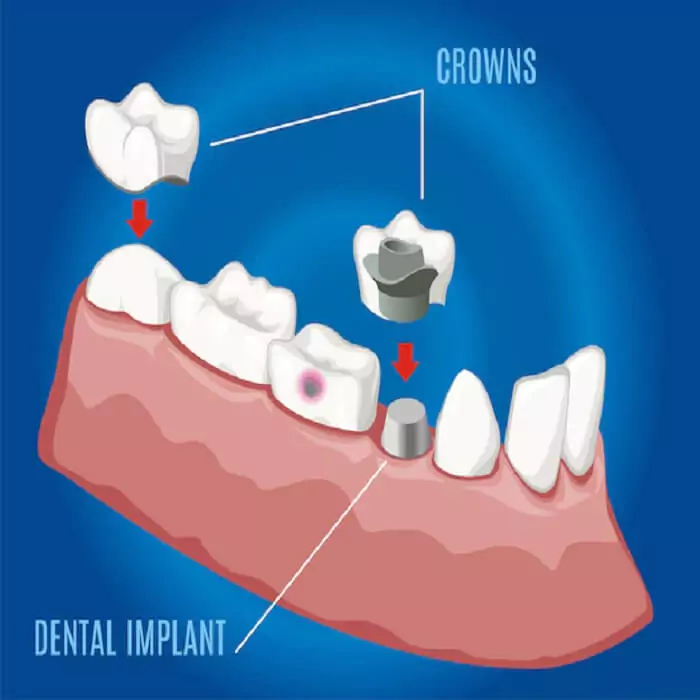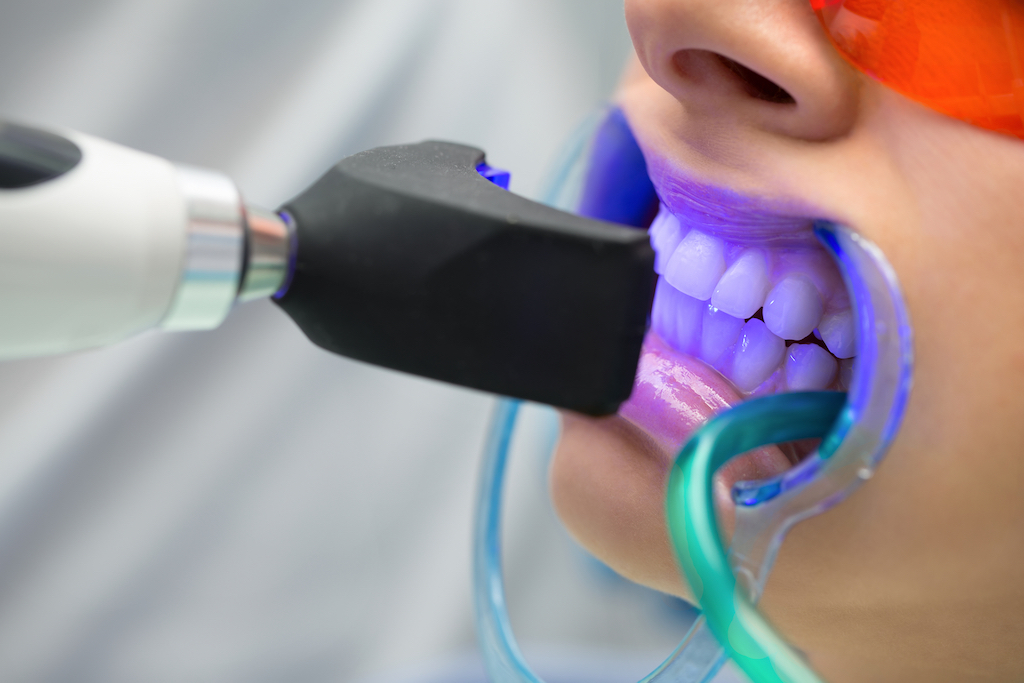A dental crown is used to cover a damaged or decayed tooth or to replace a missing tooth when it is placed on top of a dental implant. Dental implants are titanium anchors that are surgically attached to the jawbone beneath the gums. By the process of Osseointegration, these dental implants become attached to the jaw bone. This process provides strong support to rely on when eating and speaking. It takes around 6 – 12 weeks for a dental implant to heal properly. After that abutment is placed on the dental implant on which a dental crown is mounted.

Before getting a dental crown for a damaged or decayed tooth, the impression of your bite is taken. Based on that, the shape of your new tooth can be determined. Depending on the material you choose, your dental crown can be made in a single day or might take a few weeks.
A dental crown caps a damaged, weak, or decaying tooth and helps in maintaining its size, strength, shape, and appearance. Dental crowns are made with one or a mixture of various materials. Gold alloy and other alloy are the options that tend to be more durable and cost-effective. But these dental crowns don’t look and feel like natural ones.
On the other hand, porcelain, acrylic and ceramic crowns closely match the natural teeth. Among them, acrylic crowns and ceramic crowns are more durable compared with porcelain crowns as they tend more to chipping and damage. But these porcelain crowns after bonding to a metal shell, strengthen maintaining the natural aesthetic look.


As the dental bridges helps you have a missing teeth, these make your teeth work together. For one to undergo dental bridges having a strong tooth root and supporting tooth on either side of the missing teeth are must. As tooth is bonded inside the jawbone, having a high dense jaw bone tissue adds an advantage.
Before getting a dental crown for a damaged or decayed tooth, the impression of your bite is taken. Based on that, the shape of your new tooth can be determined. Depending on the material you choose, your dental crown can be made in a single day or might take a few weeks.


Unlike dental crowns, dental bridges are solely used to replace one or more missing teeth. For a dental bridge, at the outside edges of your area of loss, we will place dental crowns on filed-down teeth or dental implants. The area between the caps where the teeth are lost is filled with replacement teeth.
Like dental crowns, you have the option of choosing materials for your dental bridge. Considering the factors like the visibility of the tooth, the cost, the strength, and how it looks, we will suggest the material choice.
Dental bridges and dental crowns can last longer

If you have one or more missing teeth, getting artificial replacements is the best option to get your natural look back. There are removable choices, such as dentures, that you can take out and clean, but they slide around, move, or fall out, which many people won’t enjoy. Here comes the existence of dental crowns affixed to dental implants and dental bridges that operate more like your natural teeth. Even though you have a fake tooth or two, you will have as real a smile as possible. We at Dr.Jal Dental clinic believe that teeth play a vital role in day-to-day life. We always work at our best to deliver the best results to our patients. At our clinic, we always aim to create a comfortable, pain and anxiety-free environment.
On an average a Dental Crown and a Bridge lasts for about 15 years if the treatment and material is properly performed. With a good oral hygiene, maintenance and regular check-ups it can last up to 25-30 years also.
Dental Bridges are recommended when one or more tooth is lost entirely. Whereas, Dental Crowns are recommended to restore cracked or fractured tooth.
There are few disadvantages of Dental Bridges that one should keep in mind
Traditional and cantilever bridges both require healthy teeth to be altered. For the dental crowns to fit properly, dentists must remove a small bit of enamel from the healthy surrounding teeth during implantation. These teeth may cause complications for patients in the future.
Bone loss is not addressed by bridges. The jawbone in those places begins to degenerate when a person has one or more missing teeth, producing facial drooping, tooth movement, and subsequent tooth loss. The only approach to inhibit bone resorption and grow back that bone tissue is to replace the tooth root with a dental implant. The jawbone will continue to degenerate since bridges are placed above the gum line.
Bridges do not survive as long as implants. Dental implants are predicted to endure more than 25 years, while bridges are projected to last only a few years.
There are three main types of dental bridges traditional fixed bridges, cantilever bridges and Maryland bonded bridges. Traditional fixed Bridge is the most common or popular type of dental bridge which has false teeth that are held in place by crowns. In Cantilever Bridge the false teeth are held in its position with the help of a dental crown which is cemented to one abutment tooth. In Maryland Bonded Bridges two natural abutment teeth on each side of the space like traditional braces.
There are 4 main steps involved in preparing Dental Crowns. 1. Tooth Preparation, 2. Taking the Impression, 3. Placing a Temporary Crown, 4. Cementing a Permanent Crown Dental Bridge also more or less follows the same procedure.
Jal Microscopic Dental Clinic & RCT Hub is a one stop dental care clinic located conveniently and equipped with the finest technology at par with the international standards.